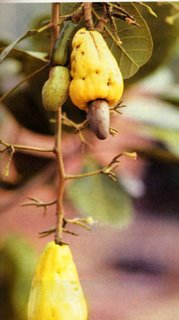
TROPICAL FRUITS
CASHEW (Anarcardium Occidentale)
Cashew, known locally as gajus, jambu monyet or jambu golok is a fast growing evergreen perennial which commonly grows to 10 meter in height. It has been in Malaysia since 1973. The more than 90% of the crop is normally planted on marginal land and bris soil especially in the east coast of Penisular Malaysia. There are two types of cashew; C11 and F2070 for commercial planting.
The planting practice normally begins with the high density cultivation of 185 trees per hectare (6 meters by 9 meters recommended planting distance) by cutting down alternate trees to avoid overcrowding and reduction in the size of the nuts.
The cashew tree takes about 4 years to reach maturity. Maximum yield can be obtained when the tree is about 8 years old and will continue to have a minimum life span for a further 12 years. The estimated production is around an average of 2,200 kg per hectare in one season.
The seed of the cashew has a more important economic value compare to the flesh of the fruit. The color of the mature seed is between grey and brown of mixture of these colors. It varies in the size, shape and weight. The quality of the cashew nut shell oil. Normally, cashew nut contains about 20% oil in the shell.
The flesh of the cashew fruit is normally used for making jam, jelly and syrup. The cashew nut shell liquid as a major nature source of phenols. The fruit is therefore a versatile and valuable raw material.
How to Eat
Only the nuts that are attached to the cashew fruit are normally eaten. The nuts must normally be cooked before they can be eaten.
To do this, separate the nuts from the rest of the fruit, wash the nuts to remove dirt and other impurities. Steam them in the autoclave for 30 – 60 minutes. Let them cool. Then, break off the shells to get the fresh kernels. The kernel can be eaten as they are or are further fried.
However, processed cashew nuts are normally available in the market. It is more convenient to buy them off the shelves.
TROPICAL FRUITS

No comments:
Post a Comment